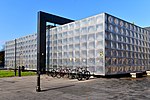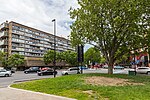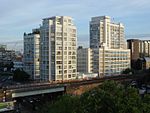Skipton House

Skipton House is a high specification office building in Elephant and Castle, Central London. It was built for a Japanese bank and then sold on to accommodate staff of the Department of Health who were moved out of Alexander Fleming House. The project architect was Paul Cayford. Its address is 80 London Road SE1 6LH, next to the Bakerloo line entrance to Elephant & Castle tube station. It was opened by Virginia Bottomley, who was then Secretary of State for Health, on 15 February 1993. Its floor area is 250,000 sq ft (23,000 m2). From outside, the two outstanding characteristics are the dark brown marble cladding and the impressive entranceway. Inside, there is a large glass-topped central atrium, with the second to sixth floors having balconies. When the Information Centre for Health and Social Care was created on April 1, 2005, its London office was in Skipton House. It has since moved to Leeds, West Yorkshire. Furthermore, during 2005 substantial numbers of Department of Health staff were moved in from nearby Eileen House and Hannibal House where those leases had expired. In 2011 a further tranche of Department of Health staff were moved in from nearby New Kings Beam House. It is the headquarters of the NHS Counter Fraud Authority.
Excerpt from the Wikipedia article Skipton House (License: CC BY-SA 3.0, Authors, Images).Skipton House
Newington Causeway, London Elephant and Castle (London Borough of Southwark)
Geographical coordinates (GPS) Address External links Nearby Places Show on map
Geographical coordinates (GPS)
| Latitude | Longitude |
|---|---|
| N 51.49603 ° | E -0.10065 ° |
Address
Skipton House
Newington Causeway
SE1 6DQ London, Elephant and Castle (London Borough of Southwark)
England, United Kingdom
Open on Google Maps








